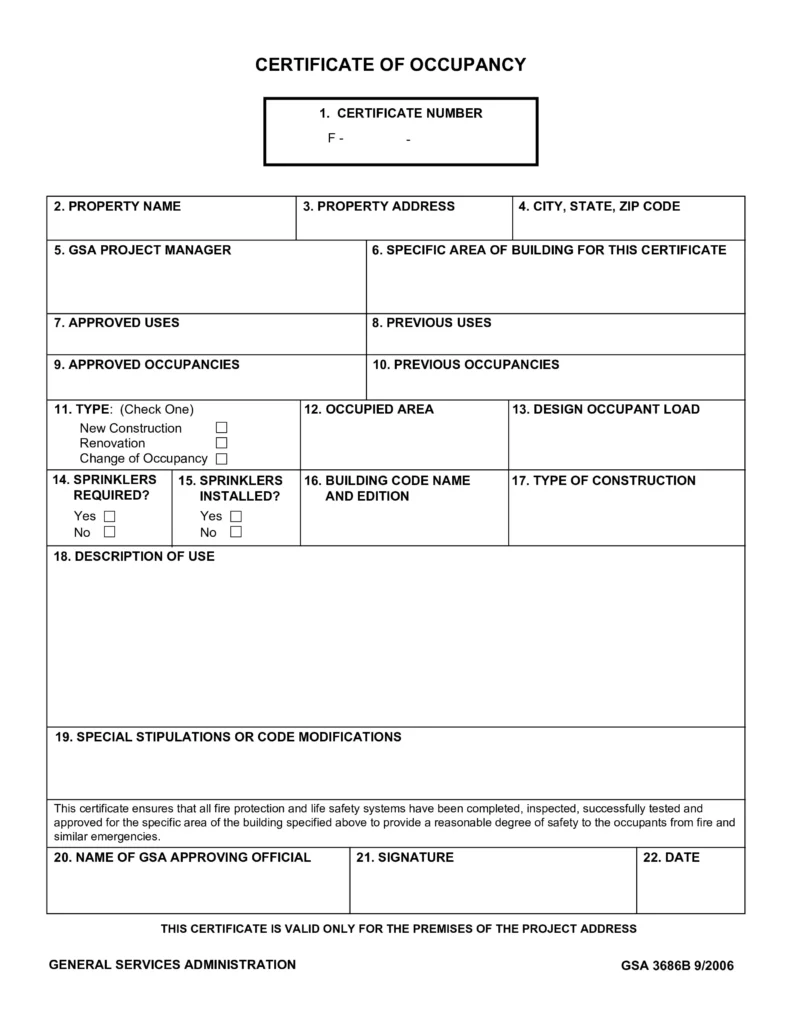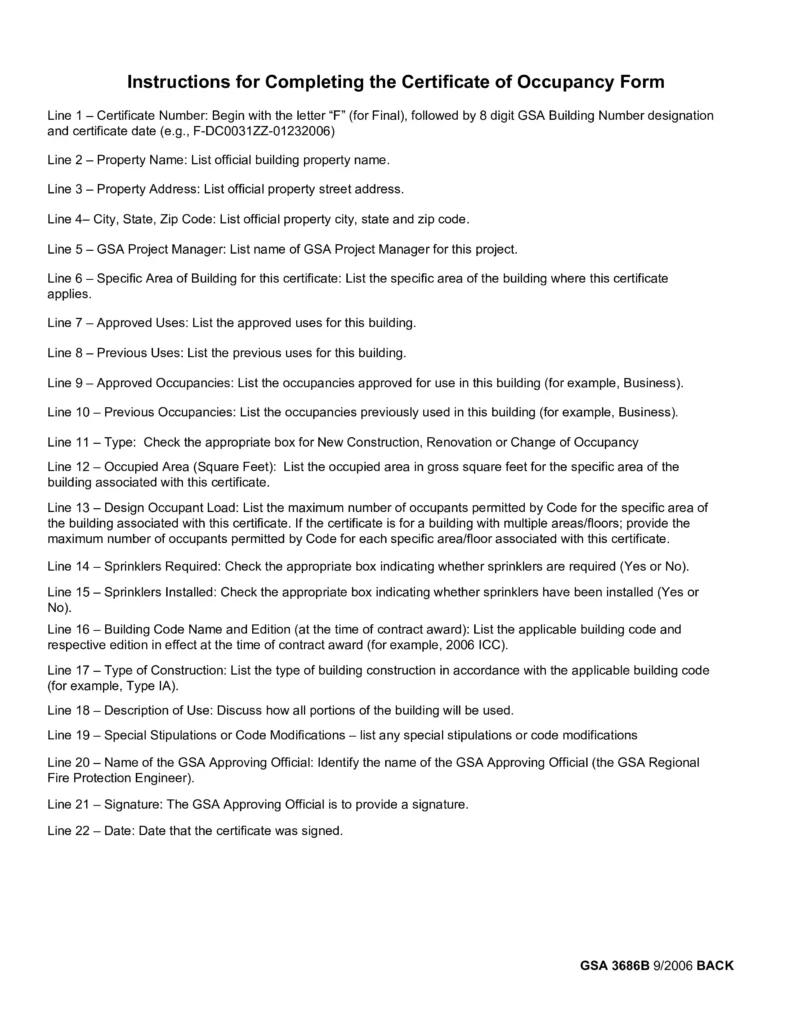Certificate of Occupancy (CO) is a legal affirmation of a structure’s habitability and compliance with local regulations. It confirms that a property has undergone the necessary inspections and that it adheres to safety guidelines and protocols. It also provides peace of mind to the house’s occupants.
Generally, all property transactions require a valid CO. It ensures that the property meets all the regulations and allows for an easier ownership transfer.
What Is a Certificate of Occupancy?
An Occupancy Certificate (OC) confirms that a building or property complies with the applicable building codes. Local government authorities or building departments issue this certificate.
The OC indicates that the building has basic services like sanitation, water, and electricity, making it more livable. Therefore, it serves as a green light for individuals to inhabit or utilize the space.
What Is a CO Inspection?
A CO inspection confirms that a property is safe for habitation and in compliance with local building codes. Authorities conduct the CO process during:
- New construction
- Renovations
- A change in property ownership
When Is a Certificate of Occupancy Issued?
A CO is issued in various situations to ensure compliance with building and zoning regulations:
- Construction of a New Building: A CO is issued when a new building is constructed, expanded, or relocated.
- Change in Use or Occupancy (Nonresidential Building): A CO is required if there is a change in the use or occupancy of an existing nonresidential building.
- Inhabiting Vacant Land: A CO is issued to verify that the structures on the land meet all requirements for occupancy.
- Change in Land Use Classification: Suppose there is a change in land use from one classification to another (e.g., residential to commercial). A CO must confirm that the new land use adheres to zoning regulations.
- Alteration of Non-Conforming Use: Suppose a property’s use does not conform to current zoning regulations but was legal in the past. A CO is required to ensure the alterations comply with the existing regulations.
Where to Get a Certificate of Occupancy?
The Development Services Department issues the occupancy certificate before allowing the occupation or use of a building or structure. They provide it based on compliance with any special use permit, plot approval, or building permit.
Who Is Responsible for Certificate of Occupancy?
The property owner is responsible for applying for a Certificate of Occupancy. However, in some cases, builders or developers may take charge of the application process, especially for new constructions.
The following individuals are responsible for CO:
- Property Owner: You must meet all necessary permits, inspections, and requirements to obtain the CO. This is especially true for existing buildings or homes.
- Developer or Builder: The developer or builder requires a CO when constructing or renovating a property. During the construction process, they ensure compliance with building codes.
- Real Estate Professionals: During home sales, an agent or a broker may guide and assist you in the CO process. They inform you about the requirements and help facilitate the necessary steps.
- Local Authorities: The final approval and issuance of the CO come from local building authorities or municipal departments. They conduct inspections, verify compliance, and, upon satisfaction, issue the CO.
How to Get a Certificate of Occupancy?
Each jurisdiction has its requirements for obtaining a CO. Here is a general guide on how to get a Certificate of Occupancy in the U.S.:
How to Apply for a CO?
Follow these steps for the application for a Certificate of Occupancy:
- Contact Local Authorities: Contact the local building or zoning inspection office for information on how to apply for a CO.
- Fill out the Application: To get a CO, fill out the form provided by the Development Services Department.
- Prepare the Documents: Collect all required documents, including building plans, compliance records, and other relevant paperwork.
- Submit Your Application: Submit the completed application and accompanying documents to the local building or zoning inspection office.
Process to Obtain CO
The process of obtaining a Certificate of Occupancy involves several steps:
- Work on Property Compliance: Apply for a CO before you start any work on the property. Ensure the property meets all applicable building codes, safety regulations, and zoning requirements.
- Pass Inspections: Schedule and pass all required inspections. Generally, the inspections may cover structural integrity, plumbing, electrical systems, and safety.
- Pay Fees: Some municipalities may require payment of fees associated with the CO application process. As a homeowner, you have to cover these costs.
- Final Walk-Through Inspection: The Department of Buildings will conduct a final inspection to verify that the property complies with all required standards.
- Temporary Certificate of Occupancy (if applicable): If additional work is necessary, the authorities issue a Temporary Certificate of Occupancy (TCO). This certificate is valid for a specified period, such as 90 days.
What Are the Requirements to Get a Certificate of Occupancy?
The documentation to obtain an occupancy certificate differs from state to state. However, common documents include:
- Project Commencement Certificate: This certificate indicates the beginning of the construction project.
- Project Completion Certificate: This document verifies the successful completion of the construction project.
- No Objection Certificate (NOC) for Fire and Safety: This certificate states that the property adheres to fire and safety regulations.
CO Requirements
Requirements for Occupancy Certificate are:
- Final Construction Inspection Sign-off
- Owner’s Cost Affidavit
- Final Plumbing Inspection Sign-off
- Final Elevator Sign-off
- An Approved Schedule of Occupancy in DOB NOW: Build
- Final Electrical Inspection Sign-off
- No Open Applications
- Final Building Survey
- No Open Violations
- Final Builders Pavement Plan (BPP)
What Is a Temporary Certificate of Occupancy?
A TCO is issued when a building has partial or temporary occupancy before all construction work is completed. It is granted when certain aspects of the construction meet safety and code requirements. TCOs usually have a limited duration, often 90 days.
The Development Services Department may issue a temporary CO provided that:
- The remaining construction of a project relates only to the outside conditions of the building, such as landscaping, and not to its safety.
- In case you are restoring a historic building or are the occupants doing the construction yourself.
How Much Does a Certificate of Occupancy Cost?
The cost of obtaining a Certificate of Occupancy varies depending on location and property type. For example, Minneapolis has no fee for a certificate of occupancy inspection. However, penalty fees may apply if re-inspection is necessary.
Certificate of Occupancy Template: An Example

Source: Gsa.gov
Instructions for Completing the Certificate of Occupancy Form

Source: Gsa.gov
Is It Possible to Sell a Home Without a CO?
If you attempt to sell a property without a valid Certificate of Occupancy, it can lead to legal complications. Moreover, buyers require this document as part of the due diligence process.
Frequently Asked Questions
How long does a Certificate of Occupancy take to be issued?
CO's are issued within a week of passing the final inspection. Nevertheless, in certain cities, you may experience delays. It's worth noting that some locals offer expedited services for a fee, allowing you to fast-track the receipt of your CO.
What happens during the Certificate of Occupancy inspection?
During a Certificate of Occupancy inspection, authorities assess whether a property complies with approved plans and local building codes. The inspection is a crucial step to obtain the CO. It ensures the property is safe and in compliance with relevant standards.
Are you required to make the repairs listed in the CO inspection?
Yes, property owners are generally required to address and rectify any issues or repairs listed during the Certificate of Occupancy inspection. These corrections are essential to bring the property into compliance with regulations and ensure it meets safety standards. Failure to meet the necessary CO requirements may delay or prevent the issuance of the CO. It impacts the property's legal status and the ability to occupy or sell it.
How to obtain a Certificate of Occupancy?
To obtain a Certificate of Occupancy, ensure the property complies with local building codes and regulations. Also, schedule and pass a final inspection conducted by the local building department.









.webp)
